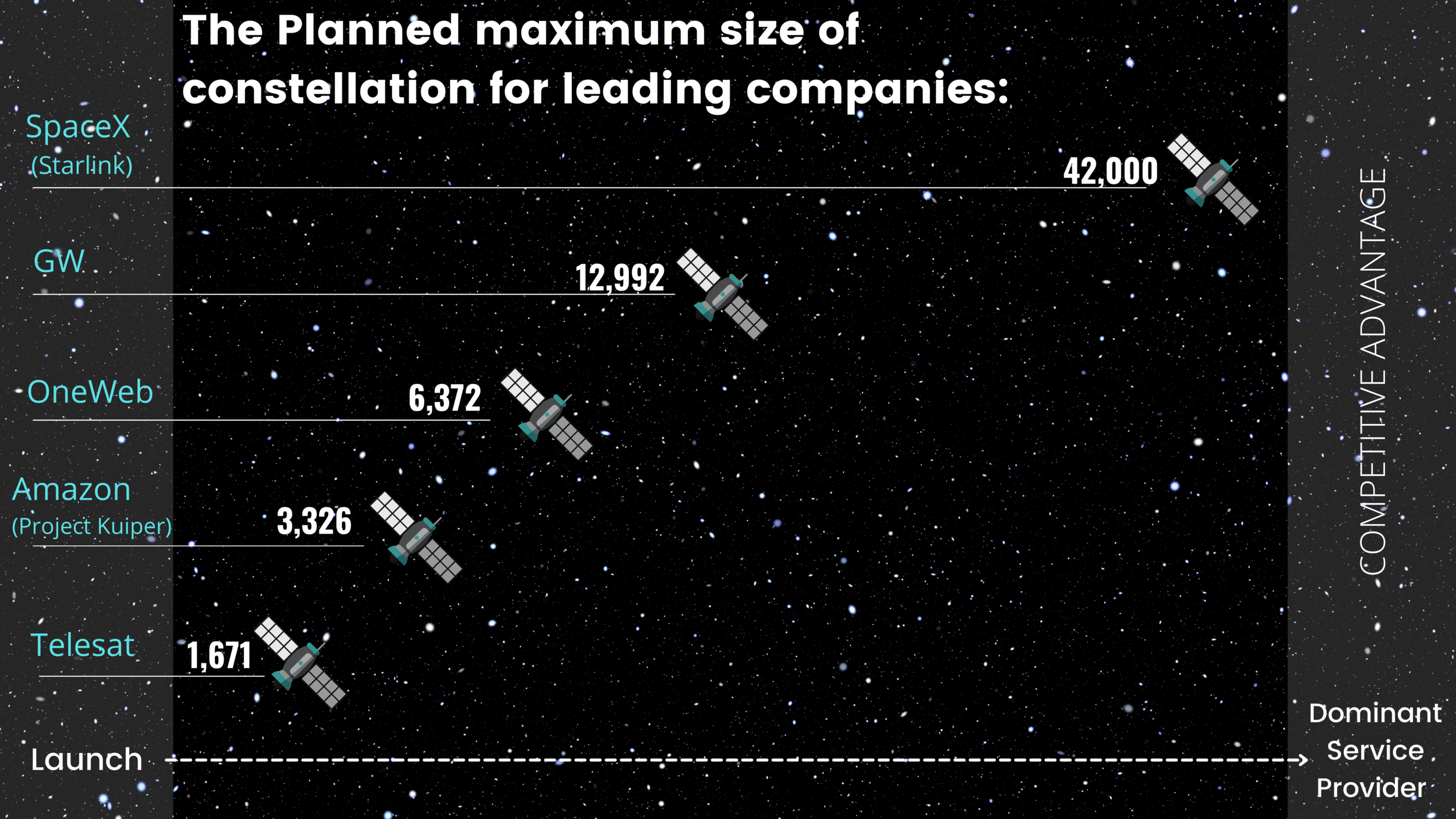The Race For Space in the ISP Market
The race to provide high-speed broadband from space is heating up. Governments and billionaires alike are striving to launch satellites and provide internet access to a global user base.
The leading competitor up to this point has been SpaceX’s Starlink, owned by the eccentric Elon Musk, and OneWeb, whose diversified ownership includes the British Government and Eutelsat, a European satellite operator that is 20% owned by the French Government [1].
However, an emerging competitor offers a credible challenge to internet space supremacy. Kuiper Systems LLC (a subsidiary of Amazon) is currently two years into “Project Kuiper” and has already gained approval from the Federal Communications Commission (FCC) in the US to deploy 3,236 satellites as part of their constellation, planned to be fully deployed by the middle of 2029 [2].
What is the Premise of this Technology?
So what exactly are these three companies racing to do? Put simply, they are launching constellations of small satellites into lower earth orbit (LEO) to beam broadband to ground stations that connect end-users to internet services. Being stationed in LEO enables the provision of relatively low latency at around 20-40ms), a significant improvement on traditional larger satellites.
The development of satellite internet is nothing new, although cable internet has dominated the market up to this point due to more competitive costs. However, enormous advances in recent years have eliminated many of the deficiencies that prevented satellite internet from achieving broad market success. Crucial to this advancement is speed, as the ultimate ambition for owners of satellite constellations is to provide internet speeds of up to 300Mbps directly to end-users.
Perhaps the biggest advantage of satellite internet is availability. As new satellite systems are deployed into orbit, consumers will be able to access internet services from almost everywhere. The use of this technology can eliminate nearly all physical installation costs associated with current broadband infrastructure that limits geographical coverage. This is especially relevant for rural areas that currently face disproportionately high costs to gain access to high-speed broadband. Gone will be the days of installing miles of cables, rather all that is required will be to simply attach a satellite dish to your home.
Not only is greater accessibility achieved but adoption of this technology could have meaningful bottom-line impacts as installation costs are dramatically reduced. This is expected to have major implications on the current fibre build in the UK market, as costs of around £100-£500 to connect a property could be shattered by a significantly cheaper solution.
Three key challenges for satellite internet providers to achieve attractive unit economics
Why Race?
While some analysts question whether satellite internet can be a viable business model targeting only remote areas, the race is very much alive with Starlink the clear frontrunner currently operating a constellation of 1,740 satellites [3]. Comparatively, OneWeb has launched only 218 satellites [3] and Amazon’s Project Kuiper is yet to deploy. Speed to deploy is crucial as Marek Ziebart explains (professor of space geodesy at University College London), “Once you’ve started to occupy a part of space by launching satellites, it’s rather like the wild west land grab: other people are going to find it much harder to operate there as well” [4]. Thus, the rewards of first-mover advantage are motivating a significant acceleration in investment to establish satellite systems ahead of the competition.
Planned spacecraft of the most important players (Source: German Institute for International and Security Affairs)
This notion of the “land grab” mentality is compounded by the issues surrounding space debris. There is a finite quantity of space in LEO. The problem of space debris currently in orbit around our planet is unlikely to get any better with huge companies launching thousands of satellites into lower earth orbit.
As seen in the graph above, there is an exponential growth in the number of satellites launched from 2010 onwards [5]. Today, there are around 11,000 satellites in orbit around the earth and 27,000 pieces of space debris, all of which pose a risk of collision [6].
Figure: Above is a representation of space debris and satelites currently surrounding our planet, note the high clustering of debris directly surrounding the planet
To further exacerbate the issue, there are no established means of cleaning up satellites once they have been launched or any associated space debris. Therefore, should collisions in space become a significant issue, the only likely response would be to prevent any further materials from entering into orbit, essentially reducing or stopping new satellites from being launched. Ultimately, due to this finite space in LEO, those who fail to launch while there is space may fail to launch at all.
Conclusion
The tantalising prospect of the benefits that this technology may bring combined with the finite nature of the availability of orbital space is contributing to an arms race. Those who can launch satellites into LEO quickly and at scale will be deemed the winners. The results of this new “space race” will reverberate back on earth, having a significant impact on how global consumers access the internet moving forwards. It soon may well be the lowest cost method to connecting consumers across the globe but to capitalise on this opportunity companies must launch quickly and claim space. The starting pistol has already sounded, the race is firmly on, we can only wait to see how it evolves.
Words by Vladimir Crasneanscki
References:
[1] https://oneweb.net/company
[2] https://www.ispreview.co.uk/index.php/2021/11/amazons-project-kuiper-preps-2-trial-leo-broadband-satellites.html
[3] https://spaceflightnow.com/2021/05/28/oneweb-surpasses-200-satellite-mark-with-soyuz-launch/
[4] https://www.theguardian.com/business/2021/oct/09/uk-takes-on-elon-musk-in-the-broadband-space-race
[5] https://www.mckinsey.com/industries/aerospace-and-defense/our-insights/look-out-below-what-will-happen-to-the-space-debris-in-orbit
[6] Santosh Kosambe, “Overview of space debris mitigation activities in ISRO,” Journal of Aircraft and Spacecraft Technology, July 2019, Volume 3, Issue 1, pp. 197–210, thescipub.com.
[7] https://www.swp-berlin.org/en/publication/satellite-internet/




